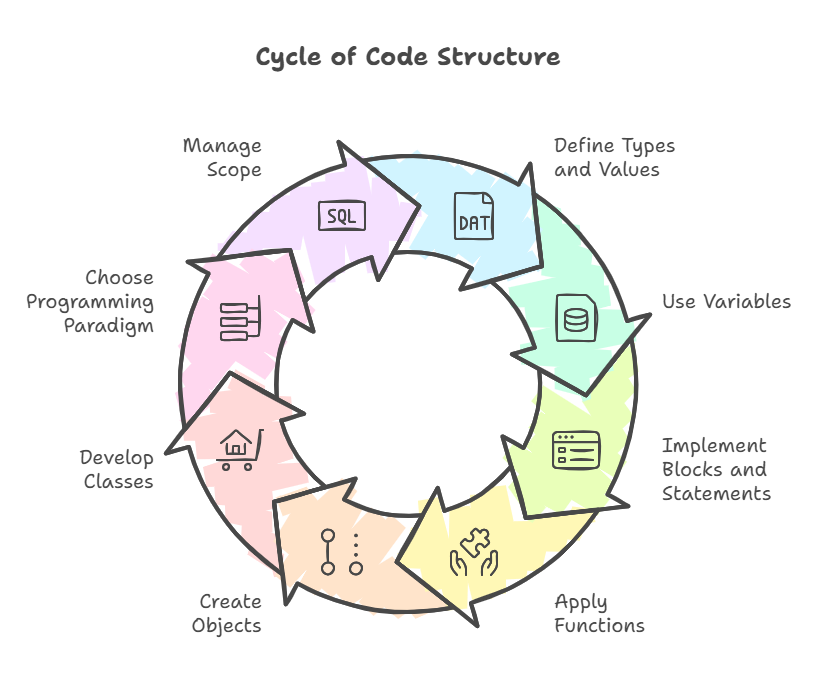JavaScript’s Lexical Structure and Code Structure
Programming in any language, including JavaScript, requires an understanding of the lexical rules that control code structure. “Lexical structure” deals with the most fundamental guidelines for producing code, whereas “code structure” generally refers to how programs are arranged into meaningful parts.
Lexical Structure JavaScript
A programming language’s lexical structure is the collection of fundamental guidelines that define how programs should be written in that language. It defines elements such as variable names, comment delimitation, and statement separation, and it is the lowest-level syntax. The language’s syntax or grammar is another name for this collection of rules.
The following are important components of JavaScript’s lexical structure:
- Case-sensitivity.
- How line breaks and spaces are handled.
- Comments can be single lines that begin with // or multi-line comments that are surrounded by /* and */.
- Literals are values, such strings or numbers, that are written directly in the code.
- Reserved terms and identifiers (such as variable names).
- Unicode support.
- Guidelines for using optional semicolons to divide sentences. It’s easier to terminate non-curly bracket statements with a semicolon, but not necessarily essential.
A parser examines a program’s text and creates a syntax tree or other data structure to reflect its grammar.
Code Structure

Code, the text of programs, contains computer instructions. Computer language grammar governs these instructions. A statement in JavaScript is a collection of characters, integers, and operators that carry out a certain function. Statements, which occasionally incorporate additional statements, are the building blocks of programs. Expressions, which are bits of code that generate a value, are frequently found in statements. Literals (such as “22” or “psychoanalysis”), expressions enclosed in parenthesis, and binary or unary operators used to other expressions are examples of expressions.
The following are essential components needed to organise code:
- Values and Types.
- Variables, Data is stored under a name using variables, also known as bindings. In essence, dealing with variables entails working with an internal object’s characteristics related to the current scope.
- Blocks and Statements: Curly braces {} can be used to group statements into blocks.
Certain kinds of statements can be used to control the control flow, or program execution flow:
- Conditional statements: Depending on the conditions, conditional statements like if, else, and switch cause disruptions in the execution flow from top to bottom.
- Looping statements: While, do, and for are examples of looping statements that enable portions of the code to be run repeatedly.
JavaScript offers strong features for managing complexity and organising larger programs:
Functions: One of the most important tools is said to be functions. They make it possible to wrap a program segment in a value. Functions aid in organising more complex programs, cutting down on duplication, giving subprograms names, and separating them from one another. In programming, they are able to define new “vocabulary” with effectiveness. Methods are a kind of data property that is frequently connected to objects or classes and has values that are functions. It is possible to define functions in one location and use them in another.
Objects: When using OOP, objects are important to logic. OOP emphasises objects, their state, and data-behavior encapsulation. Data (methods) and accessor (getters and setters) properties make up objects. The terms “enumerable” and “own property” are examples of basic object terminology.
Classes: Classes serve as an object’s blueprint. The extends keyword lets them inherit. Through inheritance, code can access a parent class’s attributes and functions, making it more manageable and reusable. Superclasses pass on inheritance to subclasses. A type of code arrangement and architecture is called class-oriented programming.
Programming Paradigms: High-level methods for organising code include programming paradigms like functional programming and object-oriented programming. The main idea behind functional programming is to use descriptive functions sequentially, paying less attention to state.
Scope is a basic idea that has to do with the organisation of code and the access to variables. The collection of guidelines that control how a variable can be looked up is known as scope. At “lexing time”, JavaScript defines lexical scope. This indicates that lexical scope is mostly determined by the time the lexer processes the code and is based on where variables and scope blocks are authored at write time.
There is a Lexical Environment for each running function, code block ({}), and the entire script. Strictly nested “scope bubbles” are produced by functions and code blocks. If you “cheat” lexical scope, it’s usually considered author-time. This keyword is another related technique. It is automatically defined in the scope of every function and typically points to an object, albeit the exact object depends on how the function was called. Lexical scope and this-style mechanisms are useful in code, but it is generally discouraged for maintainability reasons to combine both in the same function.
Web Pages and JavaScript Code Structure
The structure of web pages, which are mostly constructed with HTML and CSS, interacts with the JavaScript code structure in web development. HTML uses elements (tags) and attributes arranged in a nested structure to define the content. These elements’ display and layout are specified by CSS. The Document Object Model (DOM), a tree-like representation of the document, is produced by web browsers after processing HTML. Element nodes, which represent HTML tags; Text nodes, which represent text; and Comment nodes are among the different kinds of nodes that make up the DOM. This DOM structure is used by JavaScript to access, change, and edit the styles, properties, and content of web page elements.
